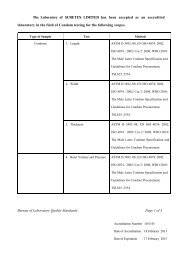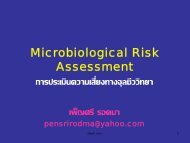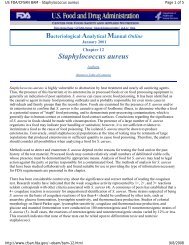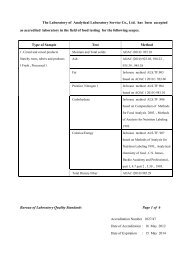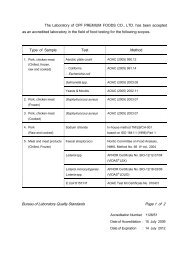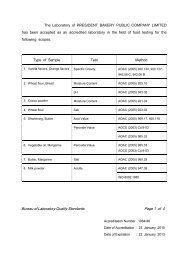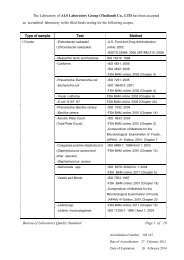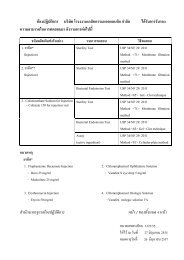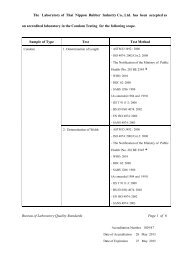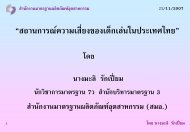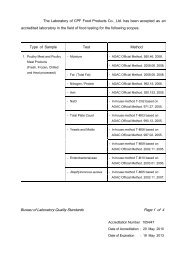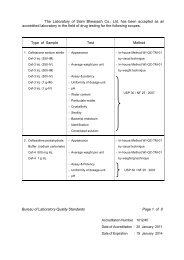à¸à¸²à¸£à¸à¸£à¸°à¹à¸¡à¸´à¸à¸à¸§à¸²à¸¡à¸à¸¥à¸à¸à¸ ัยà¸à¸à¸à¸à¸¥à¸´à¸à¸ ัà¸à¸à¹à¸¢à¹à¸à¸¡à¸à¸¡
à¸à¸²à¸£à¸à¸£à¸°à¹à¸¡à¸´à¸à¸à¸§à¸²à¸¡à¸à¸¥à¸à¸à¸ ัยà¸à¸à¸à¸à¸¥à¸´à¸à¸ ัà¸à¸à¹à¸¢à¹à¸à¸¡à¸à¸¡
à¸à¸²à¸£à¸à¸£à¸°à¹à¸¡à¸´à¸à¸à¸§à¸²à¸¡à¸à¸¥à¸à¸à¸ ัยà¸à¸à¸à¸à¸¥à¸´à¸à¸ ัà¸à¸à¹à¸¢à¹à¸à¸¡à¸à¸¡
You also want an ePaper? Increase the reach of your titles
YUMPU automatically turns print PDFs into web optimized ePapers that Google loves.
การประเมินความปลอดภัยของ<br />
ผลิตภัณฑยอมผม<br />
สิรินมาส คัชมาตย<br />
กลุมควบคุมเครื่องสําอาง<br />
สํานักงานคณะกรรมการอาหารและยา
ผลิตภัณฑยอมผม<br />
1. ครีมปรับสีผม (hair restorers) อยูในรูปครีมนวดเสนผม ซึ่งมี<br />
สารสําคัญคือ lead acetate, silver nitrate<br />
2. สียอมผมจากพืช คือเฮนนา ซึ่งเปนสีน้ําตาลทอง<br />
3. สียอมผมชั่วคราว (temporary dye) อยูในรูปของเจล มูส ครีม ผง<br />
สเปรย color rinse<br />
4. สียอมผมกึ่งถาวร (semi-permanent dye) สียอมที่ใช ไดแกกลุม<br />
nitrophenylenediamine, nitroaminophenol ซึ่งไดแก เฉดสีเหลือง มวง และ<br />
กลุม aminoanthraquinone ซึ่งไดแก เฉดสีมวงและน้ําเงิน
ผลิตภัณฑยอมผม (ตอ)<br />
5. สียอมผมถาวร (permanent hair dye, oxidative dyes, paradyes,<br />
amino-dyes) ประกอบดวย 2 สวนคือ<br />
5.1 สารทําใหเกิดสี ไดแก<br />
-primary intermediates ซึ่งเปนสารกลุม aromatic compound เชน<br />
p-phenylenediamines, p-aminophenol<br />
-couplers เชน m-diamine, m-aminophenols<br />
5.2 oxidant สวนใหญใช hydrogen peroxide
ผลิตภัณฑยอมผม (ตอ)<br />
• lead acetate: ตะกั่วเปนพิษตอสิ่งแวดลอม<br />
(ประเทศแคนาดาหามใชในผลิตภัณฑยอมผม)<br />
• silver nitrate: เปอน ลางออกยาก ใชไมสะดวก และราคาแพง<br />
• p-phenylenediamine (PPD): เกิดการแพ
การประเมินความปลอดภัยของผลิตภัณฑยอมผม<br />
• คือการประเมินความปลอดภัยของสวนประกอบของเครื่องสําอาง<br />
โดยอาศัยขอมูลทางพิษวิทยา<br />
• ขั้นตอนการประเมินความปลอดภัย<br />
1. Hazard identification<br />
2. Dose-response assessment<br />
3. Exposure assessment<br />
4. Risk characterization
Guidelines for The Safety Assessment of<br />
A Cosmetic Product<br />
1. GENERAL APPROACH<br />
• safe both for consumer and for involved professionals (e.g. hairdressers,<br />
beauticians, etc.)<br />
• skin irritation and skin sensitisation<br />
• eye tolerance<br />
• systemic toxicity resulting from percutaneous absorption or from<br />
accidental or reasonably foreseeable<br />
• As a general rule, the major basis for safety evaluation is provided by<br />
considering the toxicological profile of its ingredients.
Guidelines for The Safety Assessment of<br />
A Cosmetic Product (cont’d)<br />
2. INGREDIENTS<br />
• ingredients to be avoided<br />
• (prohibited, restricted, coloring agents, preservatives, UV filters)<br />
• sources of toxicological data<br />
• conditions of use and exposure
Safety Evaluation of Finished Products<br />
• manner of use<br />
• toxicological characteristics of ingredients<br />
• the available human experience<br />
• in vitro testing and/or skin compatibility tests
Responsibilities of The Safety Assessor<br />
1. Whether or not the ingredients present in the formula meet the<br />
requirements of the legislation<br />
2. Whether or not particular endpoint (S) have to be considered for a<br />
given ingredient<br />
3. Whether the data available are relevant and sufficient<br />
4. Whether or not interaction of toxicological relevance and/or<br />
modifications to penetration are likely to occur<br />
5. Whether or not complementary data are needed either on ingredients<br />
or on the finished product
Qualification of Safety Assessor<br />
• relevant fields for example a diploma in the field of pharmacy, toxicology,<br />
dermatology, medicine or a similar discipline and be suitably trained in<br />
the safety assessment of cosmetics
Opinion on p-Phenylenediamine<br />
• Adopted by the SCCP (Scientific Committee on Consumer Products)<br />
during the 9 th plenary meeting of 10 October 2006<br />
• Term of Reference<br />
1. Does the SCCP consider p-phenylenediamine safe for use as an<br />
oxidative hair dye with a concentration on head of maximum 2.0% taken<br />
into account the scientific data provide?<br />
2. Does the SCCP recommend any further restrictions with regard to the<br />
use of p-phenylenediamine in any oxidative hair dye formulations?
Physico-chemical specification<br />
• no data on stability, not properly characterized of water solubility
General Toxicity<br />
-acute oral toxicity: 50 mg/kg bw, lacrimation, swelling of conjuncitvae,<br />
gait, tremor, subdued behavior and/or pilorection<br />
-systemic toxicity: the most sensitive organ is skeletal muscle<br />
90 day study (gavage),<br />
NOAEL 4 mg/kg bw, end point: increase body-weight-related liver<br />
weight<br />
-developmental tox (gavage)<br />
NOAEL 5 mg/kg bw, end point: maternal tox<br />
NOAEL 10 mg/kg bw, end point: developmental tox
Irritation, Sensitisation<br />
-not irritant or corrosive for the skin and the eye when applied in a 2.5%<br />
aqueous solution<br />
-extremely potent contact allergen both experimentally and in clinical<br />
experience
Dermal Absorption<br />
-The highest cumulative penetration obtained was 4.47 ug/cm 2
Toxicokinetics<br />
The results of metabolism studies in human skin and plasma analysis after<br />
topical administration to rats suggested that topically applied PPD was<br />
converted in human and animal skin to N-mono-or-N, N’-diacetylated<br />
metabolites, detoxified derivatives.
Mutagenicity<br />
PPD<br />
Test<br />
Result<br />
in vitro -gene mutation<br />
-<br />
-micronucleus test<br />
+<br />
In vivo -micronucleus test<br />
-<br />
-unscheduled DNA synthesis test -
Mutagenicity<br />
PPD + oxidizing agent<br />
Test<br />
Result<br />
Mutagenic in bacterial cell<br />
mammalian cell<br />
+<br />
-<br />
Clastogenicity in mammalian cell -
Mutagenicity<br />
PPD + oxidizing agent + a coupler<br />
Test<br />
Result<br />
Gene mutation assay in bacteria +<br />
Gene mutation assay in mammalian cell -<br />
Chromosome aberration test -
Carcinogenicity<br />
• PPD alone has not been demonstrated to be carcinogenic in<br />
experimental studies with rats or mice.<br />
• PPD together with hydrogen peroxide may be carcinogenic in<br />
experimental studies with rats.
Safety Assessment<br />
• The maximum concentration of 4.0% of PPD is mixed before use<br />
with hydrogen peroxide. Thus the usage volume of 100 ml contains<br />
at maximum 2.0%<br />
• highest penetration (PA) = 4.47 ug/cm 2<br />
• typical body weight of human 60 kg<br />
• exposed area (scalp) 700 cm 2<br />
• systemic exposure PA x 700 cm 2 3.129 mg<br />
• systemic exposure dose (SED) PA x 700/60 x1000 = 0.052<br />
mg/kg bw
Margin of Safety (MoS)<br />
• MoS = NO(A)EL/SED<br />
• SED: The Systemic Exposure Dosage is the amount expected to enter<br />
the blood stream per kg body weight per day<br />
• NOAEL = 4 mg/kg bw<br />
• MoS = 4/0.052 = 77
Safety Assessment (cont’d)<br />
When toxicokinetic studies are considered, a minimum MoS of<br />
25 can be set. The AUC 0-24 hr in human following application a hair<br />
dye containing 14 C-labeled PPD was 0.66 ug eq *hr/ml (mean value<br />
of individual AUCs).<br />
margin of safety = NOAEL/AUC = 16.3<br />
Therefore, a margin of safety of 16.3 is not considered sufficient by<br />
SCCP.
Conclusion<br />
• carcinogenicity: PPD alone has not been demonstrated to be<br />
carcinogenic in experimental studies in rats or mice.<br />
• No conclusion can be drawn from hair dye formulation of PPD<br />
together with hydrogen peroxide studies.
Conclusion<br />
1. PPD ไมเปน genotoxic แตผลการทดสอบของ PPD รวมกับ couplers<br />
and/or hydrogen peroxide พบวา เปน genotoxic ใน in vivo/in vitro และ<br />
carcinogenicity studies<br />
2. margin of safety เทากับ 77 และหากพิจารณา toxicokinetic studies<br />
รวมในการคํานวณ margin of safety เทากับ 16.3 ซึ่งไมปลอดภัย (MoS ตอง<br />
มากกวา 100 หรือ 25 กรณีนํา toxicokinetic studies พิจารณา)<br />
3. PPD ถูกเมตาบอไลซทางผิวหนังเปน acetylated ซึ่งเปน detoxified<br />
derivatives ไมเกิดเปน mono-oxygenated derivatives, activation of PPD
Conclusion (cont’d)<br />
4. ขอมูลไมเพียงพอสําหรับการประเมินความเสี่ยง<br />
5. ขอมูลที่ตองการเพิ่มเติม ไดแก<br />
-in vivo genotoxicity and/or carcinogenicity of PPD combination with<br />
hydrogen peroxide and couplers<br />
-ขอมูลอื่นที่สนับสนุน MoS<br />
6. PPD เปนสารกอภูมิแพที่รุนแรง (extreme sensitiser) การใช PPD จึง<br />
เปนความเสี่ยงตอการแพ สิ่งที่ควรตระหนักคือ ความนิยมใชผลิตภัณฑยอมผมใน<br />
กลุมวัยรุนและการสักตัวรางกายชั่วคราวและการยอมสิ่งทอ
การกํากับดูแลผลิตภัณฑยอมผม<br />
ที่มี PPD ของประเทศไทย<br />
• เครื่องสําอางควบคุมพิเศษ<br />
• ผูผลิตและ/หรือผูนําเขา ตองขึ้นทะเบียนเครื่องสําอางควบคุมพิเศษจาก<br />
สํานักงานคณะกรรมการอาหารและยา กอนทําการผลิตหรือนําเขามาจําหนาย<br />
• อัตราสวนสูงสุดของ PPD ที่อนุญาตใหใชคือ 6.00%
คําเตือนบนฉลากของผลิตภัณฑยอมผมที่มี PPD<br />
1. ระวังอยาใหเขาตา<br />
2. ควรทดสอบการแพกอนใช (ดูวิธีการทดสอบในฉลากหรือเอกสารกํากับ<br />
เครื่องสําอาง)<br />
3. ตองหยุดใชและลางออกดวยน้ําทันที เมื่อมีอาการคัน ปวดแสบปวดรอน<br />
หรือมีเม็ดผื่นแดงบริเวณที่ใช หรือที่ถูกน้ํายา<br />
4. หามใชเมื่อหนังศีรษะมีรอยถลอก เปนแผลหรือโรคผิวหนัง และไมควรเกา<br />
ศีรษะอยางแรงในขณะสระผม<br />
5. หามใชยอมขนตาหรือขนคิ้ว<br />
6. เก็บใหพนมือเด็ก
สารกอภูมิแพ<br />
• PPD เปนสารกอภูมิแพจากการสัมผัสประจําป ค.ศ. 2006<br />
• รายงานการแพ PPD เพิ่มขึ้น<br />
-มีการผสม PPD ในผลิตภัณฑอื่นนอกจากผลิตภัณฑยอมผม<br />
-การใชผลิตภัณฑยอมผมเพิ่มมากขึ้น<br />
• ความสําคัญของการแพ PPD
การสักรางกายแบบชั่วคราว<br />
• การสักรางกายบนชั้นผิวหนัง stratum corneum และสีจะหายไปพรอมการหลุด<br />
ลอกของผิวหนัง<br />
• สีที่ใชในการสักรางกาย มาจากเฮนนา<br />
• สารสําคัญในเฮนนาคือ lawsone<br />
• รายงานการแพการสักรางกายดวยเฮนนา ซึ่งสารกอภูมิแพในการสักรางกาย<br />
ดวยเฮนนาคือ PPD<br />
• การกระตุนใหเกิดการแพ (sensitize) ตอ PPD เปนระยะเวลานานมากกวา<br />
และความเขมขนมากกวา เทียบกับการใชผลิตภัณฑยอมผมชนิดถาวร
สารเคมีที่อาจเกิดปฏิกริยาขามกับ PPD<br />
Product Class<br />
Sunscreen<br />
antiinfectives<br />
Diuretics<br />
Anesthetics<br />
Textile dyes<br />
Antidiabetics<br />
COX-2 inhibitor<br />
Rubber accelarators<br />
Chemicals<br />
PABA and padimate O<br />
Sulfonamides and p-aminosalicylic acid<br />
Thiazides<br />
Benzocaines and related caines<br />
Azo dyes<br />
Sulfonylureas<br />
Celecoxib<br />
N-isopropyl-N’-phenyl-p-phenylenediamine




